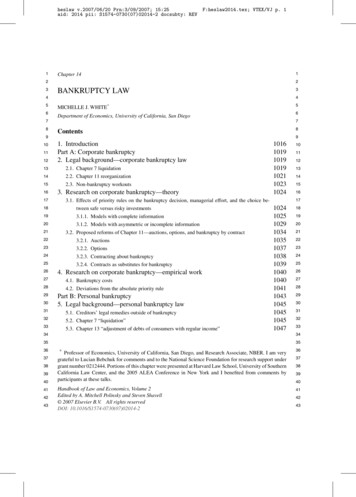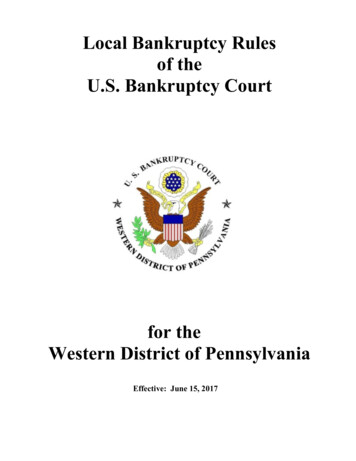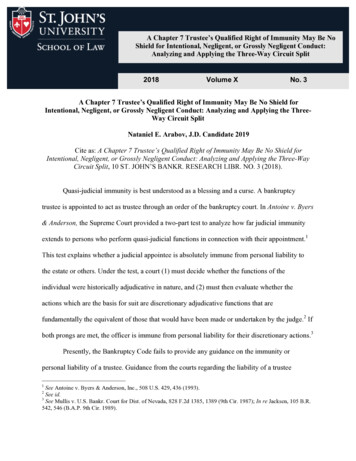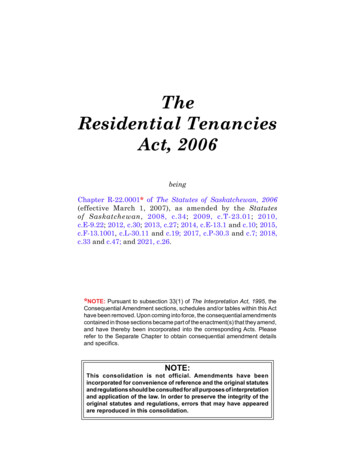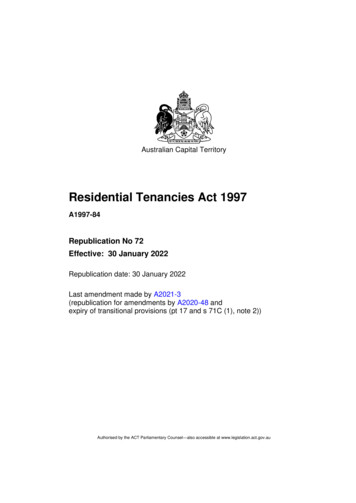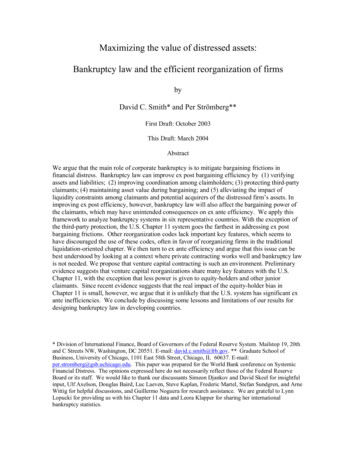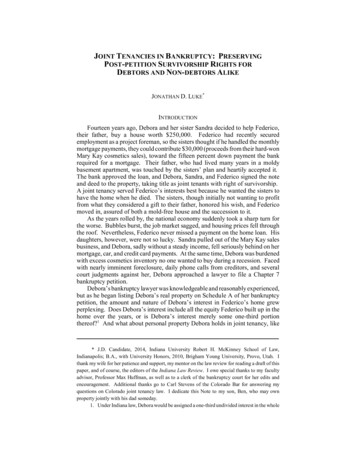
Transcription
JOINT TENANCIES IN BANKRUPTCY: PRESERVINGPOST-PETITION SURVIVORSHIP RIGHTS FORDEBTORS AND NON-DEBTORS ALIKEJONATHAN D. LUKE*INTRODUCTIONFourteen years ago, Debora and her sister Sandra decided to help Federico,their father, buy a house worth 250,000. Federico had recently securedemployment as a project foreman, so the sisters thought if he handled the monthlymortgage payments, they could contribute 30,000 (proceeds from their hard-wonMary Kay cosmetics sales), toward the fifteen percent down payment the bankrequired for a mortgage. Their father, who had lived many years in a moldybasement apartment, was touched by the sisters’ plan and heartily accepted it.The bank approved the loan, and Debora, Sandra, and Federico signed the noteand deed to the property, taking title as joint tenants with right of survivorship.A joint tenancy served Federico’s interests best because he wanted the sisters tohave the home when he died. The sisters, though initially not wanting to profitfrom what they considered a gift to their father, honored his wish, and Federicomoved in, assured of both a mold-free house and the succession to it.As the years rolled by, the national economy suddenly took a sharp turn forthe worse. Bubbles burst, the job market sagged, and housing prices fell throughthe roof. Nevertheless, Federico never missed a payment on the home loan. Hisdaughters, however, were not so lucky. Sandra pulled out of the Mary Kay salesbusiness, and Debora, sadly without a steady income, fell seriously behind on hermortgage, car, and credit card payments. At the same time, Debora was burdenedwith excess cosmetics inventory no one wanted to buy during a recession. Facedwith nearly imminent foreclosure, daily phone calls from creditors, and severalcourt judgments against her, Debora approached a lawyer to file a Chapter 7bankruptcy petition.Debora’s bankruptcy lawyer was knowledgeable and reasonably experienced,but as he began listing Debora’s real property on Schedule A of her bankruptcypetition, the amount and nature of Debora’s interest in Federico’s home grewperplexing. Does Debora’s interest include all the equity Federico built up in thehome over the years, or is Debora’s interest merely some one-third portionthereof?1 And what about personal property Debora holds in joint tenancy, like* J.D. Candidate, 2014, Indiana University Robert H. McKinney School of Law,Indianapolis; B.A., with University Honors, 2010, Brigham Young University, Provo, Utah. Ithank my wife for her patience and support, my mentor on the law review for reading a draft of thispaper, and of course, the editors of the Indiana Law Review. I owe special thanks to my facultyadvisor, Professor Max Huffman, as well as to a clerk of the bankruptcy court for her edits andencouragement. Additional thanks go to Carl Stevens of the Colorado Bar for answering myquestions on Colorado joint tenancy law. I dedicate this Note to my son, Ben, who may ownproperty jointly with his dad someday.1. Under Indiana law, Debora would be assigned a one-third undivided interest in the whole
586INDIANA LAW REVIEW[Vol. 47:585the car Debora and her husband own? Can she exempt the full value of the car,saving it from sale by the bankruptcy trustee, or is Debora entitled to exempt onlyhalf its value?2 These difficult questions led the lawyer to a broader question ofgreater impact that significantly affected Debora and her family: Will filingDebora’s bankruptcy petition sever her joint tenancies, causing them to devolveinto tenancies in common?3The joint tenancy with right of survivorship provides tenants with aconvenient way of avoiding the expense of probate in the event of sudden death,and for that reason, joint property is sometimes called “the poor man’s estateplan.”4 Thus, it comes as little surprise that when “poor” men and women fallinto bankruptcy, a joint tenant’s property interest also falls subject to theBankruptcy Code5 and the demands of creditors.6 Although it appears inDebora’s case to be a threshold issue determining the nature and extent of thebankruptcy estate, surprisingly few courts have ruled on whether filing abankruptcy petition severs a joint tenancy with right of survivorship,7 and courtsthat have decided the question merely contribute to an ever-prevailing split ofauthority.8 Facing a dearth of published work on the issue,9 this Note documentsthe extent of the split of authority on whether filing a bankruptcy petition seversa joint tenancy,10 and giving due deference to state law with respect to propertyinterest formation, urges Congress to amend the Bankruptcy Code to provide thatfiling a bankruptcy petition does not sever a joint tenancy.11 The Note presentstenancy. See infra Part III.2. Debora would likely be able to claim the full vehicle exemption allowed under state lawno matter the number of existing debtor and non-debtor cotenants. See, e.g., In re McLean, 505B.R. 361, 364 (Bank. D. Me. 2014) (holding that since joint tenants own coequal shares (per my)of the whole (per tout), the debtors, filing jointly as husband and wife, could each claim the fullstate exemption under Maine law in one of two jointly owned vehicles, thus exempting them both);In re Halcomb, No. 2:10-CV-334-WTL-DKL, 2011 WL 2133560, at *3 (S.D. Ind. May 25, 2011)(unpublished opinion) (ruling that “[b]ecause the Jeep cannot be divided, and because each Debtorhas a right to use and enjoy the whole vehicle, either the Husband or the Wife could exempt theentire value of the Jeep.”).3. See infra notes 20-21; see also infra Part III.4. 2 RICHARD L. STOCKTON, EST. TAX & PERS. FIN. PLAN. § 17:45 (Edward F. Koren ed.,2012).5. The Bankruptcy Code of 1978, 11 U.S.C. §§ 101-1532 (2006).6. See, e.g., Mangus v. Miller, 317 U.S. 178, 184 (1942) (“Utah accepts the general commonlaw rules relating to joint tenancies, including the rules permitting alienation of the interest of ajoint tenant, and making it property subject to execution and separate sale. . . . When so locallyrecognized the interest of a joint tenant is a property interest subject to the jurisdiction of thebankruptcy court. . . .”).7. See infra Part II.8. Id.9. See infra notes 31-33.10. See infra Part II.11. See infra Part V.
2014]JOINT TENANCIES IN BANKRUPTCY587draft language for such an amendment.12This Note also recommends that courts hold that filing a bankruptcy petitiononly severs a joint tenancy in a limited number of Chapter 7 cases and not in theChapter 11 or 13 case.13 In this way at least, the nature of a debtor-tenant’sproperty will not change unnecessarily when a petition is filed where the debtorintends to maintain property in its original state throughout the bankruptcyprocess. So holding would provide the benefit of preserving survivorship rightsfor Chapter 11 and 13 debtors and non-debtor cotenants once the case is closed.The preferred alternative, however, would be amending the Code itself becauseit would also preserve the survivorship rights of non-debtor cotenants who by nofault of their own have those rights terminated because a fellow joint tenant filedChapter 7 bankruptcy. These proposed changes are rooted in concepts of“fundamental fairness”14 and the idea that bankruptcy law should not alter thenature and extent of estate property unless federal reasons exist for doing so.15Short of an argument that the Bankruptcy Code causes title to estate property topass to the bankruptcy trustee,16 courts have only used state law rationales in thepast for severing joint tenancies in bankruptcy.17Courts seemingly address this severance question as part of a deathbedrepentance, postponing its address until a tenant—debtor or not—actually diesduring the bankruptcy process.18 At this point in the proceedings, playersinvolved in the bankruptcy gain a strong incentive to litigate severance becauseof the right of survivorship, the joint tenancy’s chief feature.19 The right ofsurvivorship ensures that when a joint tenant dies the surviving tenant takes theproperty “free and clear of the claims of the creditors or heirs of the deceasedtenant.”20 In contrast, a surviving cotenant’s interest in a tenancy in common “issubject to the liability of the surviving estate for the debts of the deceased tenantin common, a liability which does not exist in the case of a survivorship incident12. See infra Part V.A.13. See infra Part II.C.14. See infra Part V.B.15. See Butner v. United States, 440 U.S. 48, 54 (1979) (“Property interests are created anddefined by state law. Unless some federal interest requires a different result, there is no reason whysuch interests should be analyzed differently simply because an interested party is involved in abankruptcy proceeding. Uniform treatment of property interests by both state and federal courtswithin a State serves to reduce uncertainty, to discourage forum shopping, and to prevent a partyfrom receiving “a windfall merely by reason of the happenstance of bankruptcy.”‘ (quoting Lewisv. Manufacturers Nat’l Bank, 364 U.S. 603, 609 (1961))).16. See infra Part II.17. See infra Part II.18. See infra Part II.A-B.19. Many courts recognize the right of survivorship as the joint tenancy’s chief characteristic.See, e.g., In re Estelle’s Estate, 593 P.2d 663, 665 (Ariz. 1979) (naming the right the joint tenancy’s“distinguishing feature”); Tenhet v. Boswell, 554 P.2d 330, 334 (Cal. 1976) (its “principalfeature”); In re Estate of Thomann, 649 N.W.2d 1, 7 (Iowa 2002) (its “hallmark characteristic”).20. 48A C.J.S. Joint Tenancy § 2 (2013).
588INDIANA LAW REVIEW[Vol. 47:585to a properly created joint tenancy.”21 Therefore, when a debtor-tenant or nondebtor cotenant dies during the bankruptcy process, creditors claim that filing abankruptcy petition severs a joint tenancy and creates a tenancy in common; thesurviving cotenants, seeking the protection of the survivorship right, argue noseverance occurred.22 These arguments come before the bankruptcy court everyso often when a joint tenant dies, but this has not always been the case.Before Congress enacted the Bankruptcy Code of 1978, courts had a clearanswer to the question of whether a joint tenancy severs when a debtor-tenantfiles a bankruptcy petition. Section 70a of the then-current Bankruptcy Act of1898 provided that the bankruptcy trustee held title to all estate property once thepetition was filed.23 Given the plain language of section 70a, courts reasoned thatpassing title from the petitioner to the bankruptcy trustee disrupted unity of title,one of the four common law unities traditionally required to create and maintainjoint tenancies.24 Consequently, under the former Bankruptcy Act, courtsconcluded that a joint tenancy necessarily severed when a joint tenant filed abankruptcy petition.25However, the Bankruptcy Code of 1978 replaced the title-transfer provisionof section 70a with expansive granting language which left the courts in doubtabout whether trustees in bankruptcy continued to hold legal title to estateproperty.26 In broad strokes, section 541 of the Code provides that “all legal orequitable interests of the debtor in property as of the commencement of the case”pass to the bankruptcy estate.27 Because title no longer passes by the plainlanguage of current law to the trustee,28 the trustee’s claim on title to estateproperty is in doubt. The trustee’s current role under the Code is simply “therepresentative of the estate.”29Because of this change in bankruptcy law, courts began fighting in the 1980sover the implications for both debtor-tenants who file bankruptcies and their21. 86 C.J.S. Tenancy in Common § 5 (2013) (quoting Anson v. Murphy, 32 N.W.2d 271,273 (1948)).22. See infra Part II.23. See The Bankruptcy Act of 1898, 11 U.S.C. § 70a (1976) (repealed 1978) (“Title toProperty. a. The trustee of the estate of a bankrupt and his successor or successors, if any, upon hisor their appointment and qualification, shall in turn be vested by operation of law with the title ofthe bankrupt as of the date of the filing of the petition initiating a proceeding under this title, exceptinsofar as it is to property which is held to be exempt, to all of the following kinds of propertywherever located.”).24. See, e.g., Flynn v. O’Dell, 281 F.2d 810, 817 (7th Cir. 1960) (discussing Illinois law onseverance in view of the four unities).25. See id. (“If one joint tenant becomes a bankrupt, the involuntary transfer of his interestto the trustee, which then takes place, [presumably operates] to effect a severance. . . .”).26. See infra Part II.A-B.27. 11 U.S.C. § 541(a)(1) (2006).28. Id. § 323 (makes no mention of trustee gaining title to estate property).29. Id. § 323(a).
2014]JOINT TENANCIES IN BANKRUPTCY589fellow non-debtor cotenants.30 Former wisdom about the severance of jointtenancies became moot, and surprisingly, scholars have yet to fully unpack thesplit of authority that still plagues this issue. Although the literature on the jointtenancy itself is well developed, scholarly treatment of what happens to it in theevent of bankruptcy has fallen by the wayside. Commentators who have takenup the issue either treat one side of cases in the split as undisputed law,31 in somecases even developing legal theories based on this unsupported view,32 or mentionthe split and do not discuss its implications.33This Note clarifies the positions courts have taken on this issue, and based oncurrent bankruptcy law and justifications for holding joint tenancy property,recommends a statutory solution favoring joint tenancies given their increasingprevalence and long-standing donative utility. Simply filing a bankruptcypetition should not create millions more tenancies in common in real and personalproperty when joint tenancies were originally intended. While some creditorsmay find it easier to recoup their losses if joint tenancies immediately convert totenancies in common in the event of a tenant’s bankruptcy, there are manyreasons for avoiding this result. Severing a joint tenancy upon bankruptcydisrupts the original intent of the grantor merely because of the malfeasance orplain misfortune of the grantee, destroys what has become an important estateplanning tool,34 and as an ultimate consequence, further debilitates the bankruptdebtor in a process that is supposed to work towards his rehabilitation.35However, this recommendation does not come without due consideration givento the equitable rights of creditors. States can appropriately address the greatweight of this concern by following Indiana’s example in its treatment ofmortgage liens. Ultimately, though, Congress needs to address the overall issueby amending the Code to provide that filing a bankruptcy petition does not severa joint tenancy.Part I of the Note introduces the issue, discussing the current prevalence ofjoint tenancies and bankruptcies in general, in order to reach the conclusion thatcourts will inevitably be forced to continue to address the dying debtor-tenant ornon-debtor cotenant issue. Part II discusses the split of authority in thebankruptcy courts, contributing to it with an analysis of the different duties thetrustee fulfills under the Code’s various chapters. Part III summarizes Indiana’s30. See infra Part II.31. See, e.g., Donald L. Swanson, Bankruptcy-Probate and the Twain Shall Meet, 20CREIGHTON L. REV. 435, 446-48 (1987) (discussing only cases which hold that the tenancy severs).32. See Jacquelyn L. Mascetti, Note, Going for Broke in the Music Industry: Aligning theCode with the Interests of Recording Artists, 19 AM. BANKR. INST. L. REV. 185, 196 (2011).(relying exclusively on cases which do not sever the joint tenancy to argue that co-authors ofcopyrights should be treated as joint tenants in bankruptcy).33. See, e.g., R. H. Helmholz, Realism and Formalism in the Severance of Joint Tenancies,77 NEB. L. REV. 1, 31 (1998).34. See generally 2 STOCKTON, supra note 4, § 17:45.35. In re Morris, 10 B.R. 448, 451 (Bankr. N.D. Iowa 1981), vacated in part, 21 B.R. 816(Bankr. N.D. Iowa 1982) (stating that the ultimate goal of bankruptcy is rehabilitation).
590INDIANA LAW REVIEW[Vol. 47:585law on joint tenancies and provides a necessary state law backdrop to thediscussion overall. Part IV relies on Indiana law and decisions of courts acrossthe country to urge courts in Indiana and similarly situated states to hold thatfiling a bankruptcy petition does not sever a joint tenancy. In view of thisrecommendation, Part V concludes by providing a sample amendment to theBankruptcy Code to resolve this problem, while also considering Supreme Courtprecedent and additional justifications for such an amendment in property theoryand the Bankruptcy Code itself.I. BANKRUPTCY AND THE GROWING PREVALENCE OF THE JOINT TENANCYWITH RIGHT OF SURVIVORSHIPThis particular severance problem will continue to compound in the courtsuntil Congress amends the Code because of two considerations that, when takentogether, form a recipe for continued confusion. First, the use of the joint tenancyas a form of property ownership has been increasing steadily throughout the pastcentury, and indications are that this trend will continue.36 Second, bankruptcyhas taken its place as a mainstay of the U.S. economy, and based on current data,the number of bankruptcies in the United States is increasing, or at the very least,the number of filings per year remains high irrespective of the economicclimate.37 The interaction of these two variables will inevitably force courts toface more cases of dying debtor-tenants or non-debtor cotenants in the future.And because the Code is unclear on whether severance occurs upon filingbankruptcy, further cases will only contribute to the current split of authority.Given that bankruptcy law is at its core code-based, a statutory solution isnecessary to protect survivorship rights that have been the defining characteristicof the joint tenancy for hundreds of years.A. Joint Tenancies Were Historically FavoredThe joint tenancy has been in use since the Middle Ages as an efficient meansof passing property from one tenant to another, admittedly without the dreadedincidents which accompanied a property-holder’s death. However, tax interestsnotwithstanding, during the Middle Ages, the common law favored jointtenancies over tenancies in common. The joint tenancy allowed owners toconsolidate a fee interest in the hands of a few individuals, which made feudalservices and incidents easier to enforce at the time.38 Additionally, the jointtenancy remained the only means of estate planning for many years. Theseconsiderations caused courts to find a presumption in favor of joint tenancycreation.Slow changes in English law from 1500-1700 CE, while at times eliminatingthe need for this presumption, nevertheless did not cause the joint tenancy to fall36. See infra Part I.B.37. Id.38. PAUL GOLDSTEIN & BARTON H. THOMPSON, JR., PROPERTY LAW: OWNERSHIP, USE, ANDCONSERVATION 738 (Robert C. Clark et al. eds., 2006).
2014]JOINT TENANCIES IN BANKRUPTCY591out of favor. The Statute of Uses in 1535 transformed equitable estates into legalestates and eliminated the need for the presumption in favor of joint tenancies.39Statutes adopted in 1539 and 1540 allowed for the partition of land, includingjoint tenancies.40 The Statute of Wills in 1540 provided for direct succession ofproperty at death, finally provisioning a legal alternative to joint tenancies.41Ultimately, the Statute of Tenures in 1660 abolished feudal dues.42These statutes, though illustrating feudalism’s steady decline, did notoverturn property holders’ favor of the joint tenancy, however.43 Once the needfor feudal dues was eliminated, property holders still saw the survivorship rightsattached to a joint tenant’s interest as a great benefit to their estate and heirs.44These benefits, derived from the equitable title that each joint tenant held, weremanifold:[T]he joint tenancy gained strength as a means of avoiding the chargespayable to the overlord on succession at death (i.e., the relief). Theinability to transfer freely at death, the limitations on the types of futureinterests that could be created, and the problem of a minor heir could allbe avoided by delaying legal succession of land ownership at death. Bytransferring the land to a group of individuals as joint tenants, successionwas avoided until the last of the joint tenants finally died. Joint tenancy,thus, separated equitable ownership (‘for the use of’) from legalownership.45Therefore, as the legal strictures that held feudalism in place slowly gave way,property owners still found that the joint tenancy served their best interests as away to evade incidents at death.46 Because legal title did not pass to an heir untilall joint tenants died, death taxes did not mature immediately upon a grantor’sdeath.47 However, the presumption in favor of joint tenancy creation did not lastlong.48 Perhaps paradoxically, the very elements that made a joint tenancydesirable in England from the Middle Ages through the Late Renaissance causedthe joint tenancy to fall into nearly universal legal disfavor as the new AmericanRepublic was born.4939. Stephanie J. Willbanks, Taxing Once, Taxing Twice, Taxing Joint Tenants (Again) atDeath Isn’t Nice, 9 PITT. TAX REV. 1, 4-5 (2011).40. Id.41. Id.42. Id.43. Id. at 4.44. Id.45. Id.46. Id.47. Id.48. Id. at 5.49. Id.
592INDIANA LAW REVIEW[Vol. 47:585B. Joint Tenancies Are Currently Disfavored at Law but Are Widely in UseIn a trend that began in early nineteenth century America, state statutes beganto disfavor the creation of joint tenancies.50 Although tax benefits at deathremained in place, courts and legislatures continued to object to the right ofsurvivorship, the joint tenancy’s most distinctive feature, as “an ‘odious thing’that too often deprived a man’s heirs of their rightful inheritance.”51 Followingthis trend, which works in favor of devisees, assignees, and intestate heirs,modern state statutes and courts continue—nearly universally—to announcedisfavor with the joint tenancy as a form of property ownership.52However, despite the current presumption against joint tenancy creation,many states provide for the creation of joint tenancies by statute or commonlaw.53 Persons living together, whether as couples or in groups, take liberaladvantage of these statutes. For example, one scholar noted in the mid-1980s that“[the joint] tenancy is the most popular form of spousal residential propertyownership in the United States. Indeed, it is safe to say that millions of land titlesrepresenting billions of dollars of capital investment are held in joint tenancy inthis country.”54 It is also notable that “[m]any same-sex couples view jointtenancy with its automatic right of survivorship as an attractive way to own theirproperty.”55Empirical evidence demonstrates that use of the joint tenancy in the UnitedStates has increased significantly over the past century. As part of a resurgenceof interest in the joint tenancy as a form of property ownership, legal scholars inthe 1960s published a study of real estate deeds of counties in Californiarevealing that, in 1959 and 1960, residents held over two-thirds of the property50. GOLDSTEIN & THOMPSON, supra note 38, at 740.51. N. William Hines, Real Property Joint Tenancies: Law, Fact, and Fancy, 51 IOWA L.REV. 582, 585 (1966), cited in GOLDSTEIN & THOMPSON, supra note 38, at 740.52. See, e.g., Larson v. Anderson, 167 N.W.2d 640, 644-45 (Iowa 1969) (“Our court as earlyas 1869 . . . said that estates in joint tenancy are disfavored by our law.”); Edwin Smith, L.L.C. v.Synergy Operating, L.L.C., 285 P.3d 656, 663 (N.M. 2012) (“Th[e] preference for tenancies incommon over joint tenancies has been incorporated into our law since territorial times.”); Smithv. Cutler, 623 S.E.2d 644, 647 n.4 (S.C. 2005) (“[C]ourts have moved away from construinglanguage in conveyances in favor of a joint tenancy.”).53. The number of states that allow for joint tenancies is a topic of dispute (mainly on thequestion of whether a state that allows for tenancies by the entireties for married couples alsoallows for a joint tenancy held by those couples), but it is accepted that the vast majority of statesallow for common law joint tenancies or a statutory variant. See Samuel M. Fetters, An Invitationto Commit Fraud: Secret Destruction of Joint Tenant Survivorship Rights, 55 FORDHAM L. REV.173, 173 n.1 (1986) (refuting the idea that the twenty-two states which allow tenancies by theentirety between married couples do not also allow them to hold their property as joint tenants).54. Id. at 173-74.55. 1 PATRICIA A. CAIN, SEXUAL ORIENTATION AND THE LAW § 5:24 (Karen Moulding ed.,2012).
2014]JOINT TENANCIES IN BANKRUPTCY593as cotenants.56 Additionally, eighty-five percent of the couples held the propertyas joint tenants.57 A second study published in 1966 found that joint tenancies inIowa “rose from less than 1 percent of land acquisitions in 1933 to over a thirdof farm acquisitions and over half of urban acquisitions in 1964.”58More recent studies confirm the growing trend toward using the joint tenancyas a preferred form of property ownership. A survey in 1999 of three hundredrandomly selected deeds in Michigan discovered twenty-four of the deeds“specified a joint tenancy. Of those 24 deeds, four (16.7 percent of the jointtenancy deeds) described the grantees as joint tenants without express words ofsurvivorship. The other 20 (83.3 percent) all specified some form of a right ofsurvivorship.”59 And, more broadly, in a sample of deeds recorded in 1890, 1920,1940, 1960, and 1980, in Bucks County, Pennsylvania, “nearly all real estate wasin the name of a single individual. Usually the husband in a married couple tooktitle solely for the pair; however, by 1980, almost 70% of Bucks County deedsnamed a husband and wife as co-grantees—typically as joint tenants with rightof survivorship.”60This Author was unable to find a published study rebutting this evidence.Although some scholars and practitioners recommend that married couples takeadvantage of the more durable survivorship rights attached to tenancies by theentirety,61 the great weight of the evidence supports the conclusion that over thepast century persons living together have increasingly favored the joint tenancyas a form of property ownership.62 This tendency appears to continue despite theongoing legal presumption against joint tenancy creation in courts and statelegislatures.63 Therefore, because the joint tenancy has proven resilient andpopular in the face of this adverse presumption, and because no contradictingevidence suggests otherwise, the joint tenancy will likely continue as a permanentand well-used feature of American property law for years to come.56. Yale B. Griffith, Community Property in Joint Tenancy Form, 14 STAN. L. REV. 87, 88n.4 (1961).57. Id.58. GOLDSTEIN & THOMPSON, supra note 38, at 740 (construing Hines, supra note 51, at586).59. Byron D. Cooper, Continuing Problems with Michigan’s Joint Tenancy “With Right ofSurvivorship,” 78 MICH. B.J. 966, 966 (1999).60. CAROLE SHAMMAS ET AL., INHERITANCE IN AMERICA FROM COLONIAL TIMES TO THEPRESENT 172 (1987), cited in Robert C. Ellickson, Unpacking the Household: Informal PropertyRights Around the Hearth, 116 YALE L.J. 226, 261 (2006).61. See, e.g., Damaris Rosich-Schwartz, Tenancy by the Entirety: The Traditional Versionof the Tenancy Is the Best Alternative for Married Couples, Common Law Marriages, and SameSex Partnerships, 84 NOTRE DAME L. REV. 23, 24 (2008) (listing asset protection, probateavoidance, and protection against unilateral severance as some of the possible overarchingadvantages of a tenancy by the entirety).62. See supra notes 50-60 and accompanying text.63. See supra notes 50-52 and accompanying text; see also Part III.
594INDIANA LAW REVIEW[Vol. 47:585C. The Widespread Use of Bankruptcy and the Inevitability ofMore Court ConflictThe United States has also experienced a widespread use of the bankruptcyprocess in recent years to discharge, repay, and reorganize debt. In the UnitedStates, 1,311,602 people filed bankruptcy from June 2011 to June 2012 alone.64Yearly filings as reported in June since 2000 have consistently been over onemillion, except for the years 2007 and 2008.65 It is widely speculated that thisdecrease was due to uncertainties caused by the Bankruptcy Abuse Preventionand Consumer Protection Act (BAPCPA), which was taking effect at the time.66However, towards the end of the Great Recession of 2007-2009, yearlyfilings increased to over one million once again in 2009 and exceeded 1.5 millionin both 2010 and 2011.67 Furthermore, even if the U.S. economy returns to peakoutput levels as experienced during the mid-to-late 1990s, it is likely that thenumber of bankruptcies filed in the United States will remain high becausenational filings consistently exceed one million even during relatively healthyeconomic periods.68The social stigma that once attached to bankruptcy is perhaps also fading,thus contributing a social factor to the greater number of bankruptcy filings.69One commentator has pointed to two social causes for the increased publicperception that bankruptcy is losing its stigma: one, a “shifting societal attributionof fault [to outside forces] for financial failure;” and two, the decline of “bothguilt internalization and external non-legal sanctions [like the shaming and64. THE UNITED STATES COURTS, U.S. BANKRUPTCY COURTS—BANKRUPTCY CASESCOMMENCED, TERMINATED AND PENDING DURING THE 12-MONTH PERIODS ENDING JUNE 30, 2011AND 2012, TABLE F (2012).65. THE UNITED STATES COURTS, U.S. BANKRUPTCY COURTS—BANKRUPTCY CASESCOMMENCED, TERMINATED AND PENDING DURING THE 12-MONTH PERIODS ENDING JUNE 30, 2007AND 2008, TABLE F (2008); THE UNITED STATES COURTS, U.S. BANKRUPTCY COURTS—BANKRUPTCY CASES COMMENCED, TERMINATED AND PENDING DURING THE 12-MONTH PERIODSENDING JUNE 30, 2006 AND 2007, TABLE F (2007).66. Lois R. Lupica, The Costs o
Bankruptcy Code5 and the demands of creditors.6 Although it appears in Debora's case to be a threshold issue determining the nature and extent of the bankruptcy estate, surprisingly few courts have ruled on whether filing a bankruptcy petition severs a joint tenancy with right of survivorship, 7 and courts

